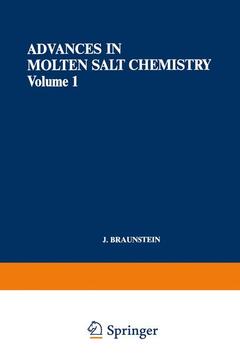Description
Advances in Molten Salt Chemistry, Softcover reprint of the original 1st ed. 1971
Volume 1
Authors: Braunstein J., Mamantov Gleb, Smith G. P.
Language: English
Subject for Advances in Molten Salt Chemistry:
Approximative price 52.74 €
In Print (Delivery period: 15 days).
Add to cart
Publication date: 06-2012
284 p. · 15.2x22.9 cm · Paperback
284 p. · 15.2x22.9 cm · Paperback
Description
/li>Contents
/li>
Molten salts are investigated by very diverse techniques and for differ ing purposes, and the results are reported in widely scattered journals. There is a need to keep investigators aware of progress in other specialties and to provide students with source and background material. Advances in Molten Salt Chemistry hopes to fill these needs by providing reviews of recent progress presented, insofar as is reasonable, with enough background material and commentary to be comprehensible to a nonspecialist. We prefer a discussion of underlying principles, to the extent that they are known, and we encourage authors to comment critically on the reliability of data, the utility of models, and the cogency of ideas and theories. We take a broad vie~ of the suitability of topics for inclusion in this series. Both fundamental and technological advances have a place here, as do studies on materials related to molten salts (like liquid silicates, very concentrated aqueous solutions, solutions of salts in liquid metals, and solid electrolytes). We intend this series to serve the needs of those who investigate or use molten salts. We welcome suggestions of topics and suitable authors, as well as comments on the strengths and shortcomings of what is published.
1 Vibrational Spectroscopy of Molten Salts.- 1. Principles of Infrared and Raman Spectroscopy.- 1.1. Introduction.- 1.2. Molecular vibrations.- 1.3. Normal modes.- 1.4. Infrared and Raman spectra: Selection rules.- 2. Experimental Techniques.- 2.1 Spectrometer Modifications for Molten Salt Work.- 2.2. Transmission, Reflectance, and Emission Infrared Methods.- 2.3. Arc Lamps, Discharge Lamps, and Lasers as Raman Light Sources.- 2.4. Sample Cells.- 3. Results.- 3.1. Monatomic Ions.- 3.2. Polyatomic Ions.- 3.3. Covalent Melts.- 4. Theoretical Problems.- References.- 2 Liquid Extraction from Molten Salts.- 1. Introduction.- 1.1 The Scope of the Survey.- 1.2. Experimental Techniques.- 2. Thermodynamics of the Distribution.- 2.1. Activities in Molten Salt Systems.- 2.2. Activities from Distribution Measurements.- 2.3. Thermodynamic Functions of Transfer.- 3. Immiscible Molten Salts.- 3.1. Thermodynamics of Immiscible Molten Salts.- 3.2. Criteria for Immiscible Salt Systems.- 3.3. Survey of Systems with Miscibility Gaps.- 4. The Kinetics of the Distribution.- 4.1. Diffusion Controlled Rates.- 4.2. Rates Controlled by Boundary Crossing.- 4.3. Rates Controlled by Slow Chemical Reactions.- 5. Survey of Selected Distribution Systems.- 5.1. Distribution of Solutes between Molten and Liquid Bismuth.- 5.2. Distribution of Solutes between Molten Borates and Molten Halides.- 5.3. Distribution of Solutes between Molten and Aromatic Solvents.- 5.4. Extraction from Molten Salts with Long-Chain Amine Salts.- 5.5. Miscellaneous Systems Recently Studied.- 6. Concluding Remarks.- References.- 3 Molten Salt Chemistry of the Haloaluminates.- 1. Introduction.- 2. The Aluminum Halides.- 2.1. Physical and Thermodynamic Properties.- 2.2. Structure.- 2.3. Solvent Properties.- 2.4. Electrical Conductivity.- 2.5. Subvalent Species.- 3. Physical Properties of Salt Mixtures Containing Aluminum Halides.- 4. Phase Studies and Thermodynamic Properties of Salt Mixtures Containing Aluminum Halides.- 4.1. Phase Studies.- 4.2. Alkali Metal Halide—Aluminum Halide Mixtures.- 5. Spectroscopy and Structure.- 5.1. Raman Spectroscopy.- 5.2. Crystal Structures.- 6. Solvent Properties.- 6.1. Acid-Base Systems and Solubilities.- 6.2. Stabilization of Subvalent Species.- 6.3. Spectroscopy.- 6.4. Electrochemical Studies of Solutes.- 6.5. Immiscible Liquid Studies.- 7. Electrochemistry.- 7.1. Conductivity.- 7.2. Decomposition Potentials, Electrolysis and Other Electrochemical Studies.- 8. Technological Applications.- 9. Melt Preparation and Handling.- Acknowledgments.- References.- 4 Molten Salt Batteries and Fuel Cells.- 1. Introduction.- 1.1. Scope.- 1.2. Advantages of Molten Salt Electrolytes.- 1.3. Disadvantages of Molten Salt Electrolytes.- 2. General Discussion.- 2.1. Cell emf’s.- 2.2. Electrode Polarization.- 2.3. Energy and Power Limits.- 2.4. Self Discharge.- 3. Specific Battery Systems.- 3.1. Concentration Cells.- 3.2. Thermal Batteries.- 3.3. Lithium-Chlorine Cells.- 3.4. Sodium-Sulfur Cell.- 4. Fuel Cells.- 4.1. Carbonate Fuel Cell.- 4.2. Solid Oxide Fuel Cell.- 5. Other Systems.- References.- 5 Thermodynamic Studies, by Mass Spectrometry, of Molten. Mixed Halide Systems.- 1. Introduction.- 2. Experimental Techniques.- 2.1. Use of Total Vaporization Isotherms for Mass Spectrometric Determination of the Partial Pressures and Relative Ionization Cross Sections of Molecules.- 3. Results for Binary Systems.- 3.1. Group IA-IA Halide Systems.- 3.2. Group IA-II Halide Systems.- 3.3. Group IA-III Halide Systems.- 3.4. Group IA-IVA Halide Systems.- 3.5. Group IA-Transition Metal Halide Systems.- 3.6. Group IA-Rare Earth Halide Systems.- 3.7. Group IA-Actinide Halide Systems.- 4. Reciprocal and Similar Systems.- 5. Miscellaneous Mixed Halide Reactions.- 6. Structures and Unifying Concepts.- References.- Author Index.- Formula Index.
© 2024 LAVOISIER S.A.S.




